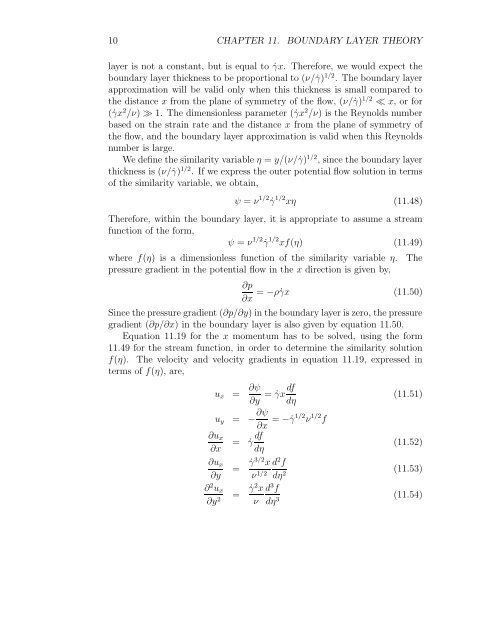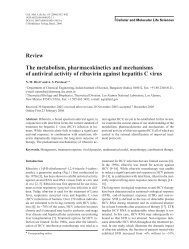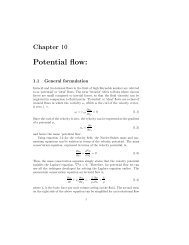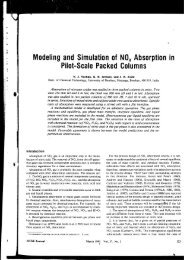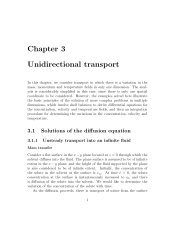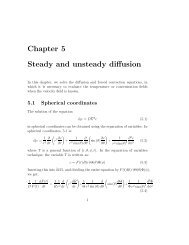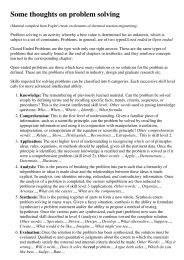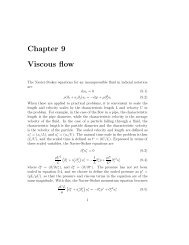Chapter 11 Boundary layer theory
Chapter 11 Boundary layer theory
Chapter 11 Boundary layer theory
Create successful ePaper yourself
Turn your PDF publications into a flip-book with our unique Google optimized e-Paper software.
10 CHAPTER <strong>11</strong>. BOUNDARY LAYER THEORY<br />
<strong>layer</strong> is not a constant, but is equal to ˙γx. Therefore, we would expect the<br />
boundary <strong>layer</strong> thickness to be proportional to (ν/˙γ) 1/2 . The boundary <strong>layer</strong><br />
approximation will be valid only when this thickness is small compared to<br />
the distance x from the plane of symmetry of the flow, (ν/˙γ) 1/2 ≪ x, or for<br />
(˙γx 2 /ν) ≫ 1. The dimensionless parameter (˙γx 2 /ν) is the Reynolds number<br />
based on the strain rate and the distance x from the plane of symmetry of<br />
the flow, and the boundary <strong>layer</strong> approximation is valid when this Reynolds<br />
number is large.<br />
We define the similarity variable η = y/(ν/˙γ) 1/2 , since the boundary <strong>layer</strong><br />
thickness is (ν/˙γ) 1/2 . If we express the outer potential flow solution in terms<br />
of the similarity variable, we obtain,<br />
ψ = ν 1/2 ˙γ 1/2 xη (<strong>11</strong>.48)<br />
Therefore, within the boundary <strong>layer</strong>, it is appropriate to assume a stream<br />
function of the form,<br />
ψ = ν 1/2 ˙γ 1/2 xf(η) (<strong>11</strong>.49)<br />
where f(η) is a dimensionless function of the similarity variable η. The<br />
pressure gradient in the potential flow in the x direction is given by,<br />
∂p<br />
∂x<br />
= −ρ˙γx (<strong>11</strong>.50)<br />
Since the pressure gradient (∂p/∂y) in the boundary <strong>layer</strong> is zero, the pressure<br />
gradient (∂p/∂x) in the boundary <strong>layer</strong> is also given by equation <strong>11</strong>.50.<br />
Equation <strong>11</strong>.19 for the x momentum has to be solved, using the form<br />
<strong>11</strong>.49 for the stream function, in order to determine the similarity solution<br />
f(η). The velocity and velocity gradients in equation <strong>11</strong>.19, expressed in<br />
terms of f(η), are,<br />
u x = ∂ψ<br />
∂y = ˙γxdf dη<br />
(<strong>11</strong>.51)<br />
u y = − ∂ψ<br />
∂x = −˙γ1/2 ν 1/2 f<br />
∂u x<br />
= ˙γ df<br />
∂x dη<br />
(<strong>11</strong>.52)<br />
∂u x<br />
= ˙γ3/2 x d 2 f<br />
∂y ν 1/2 dη 2 (<strong>11</strong>.53)<br />
∂ 2 u x<br />
= ˙γ2 x d 3 f<br />
∂y 2 ν dη 3 (<strong>11</strong>.54)


